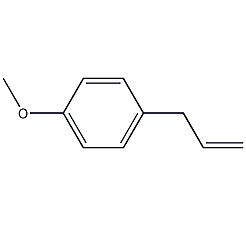
Structural formula
| Business number | 03T7 |
|---|---|
| Molecular formula | C10H12O |
| Molecular weight | 148.20 |
| label |
1-methoxy-4-(2-propenyl)benzene, p-allyl anisole, 4-allylanisole, 3-(p-Methoxyphenyl)propene, P-Allylanisole, O-Methylchavicol, 1-Methoxy-4-(2-propenyl)-benzen, Estragole, food additives, Flavor enhancer |
Numbering system
CAS number:140-67-0
MDL number:MFCD00008653
EINECS number:205-427-8
RTECS number:BZ8225000
BRN number:1099454
PubChem number:24845877
Physical property data
1. Physical property data
1. Properties: colorless liquid with anise and grass aroma.
2. Density (g/mL, 25/4℃): 0.965
3. Refractive index(n20 D): 1.5195
4. Flash point (ºC): 81
5. Boiling point (ºC, normal pressure): 216, 102ºC (2133pa)
6. Solubility: soluble in ethanol and chloroform, insoluble in water
7. Relative density (20℃, 4℃): 0.9612
8. Liquid phase standard hot melt (J·mol-1·K-1): 353.5
Toxicological data
2. Toxicological data:
1. Acute toxicity: Rat oral LD50: 1230 mg/kg;
Rat intraperitoneal LD50: 1030 mg/kg;
The mouse is LD50: 1250 mg/kg;
Rabbit skin LD50:> 5 mg/kg;
Mouse abdominal cavity LD50: 1260 mg/kg .
2. Chronic toxicity/carcinogenicity
Mouse oral TDLo: 97 gm/kg/1Y-C;
Mouse intraperitoneal TDLo: 111 mg /kg;
Mouse subcutaneous TDLo: 140 mg/kg/22D-I
Mouse oral TD: 195 gm/kg/1Y-C
3. Teratogenicity
Rat oral: 2 gm/kg
Mouse abdominal cavity: 80mg/kg
Ecological data
3. Ecological data:
1. Other harmful effects: This substance may be harmful to the environment, and special attention should be paid to water bodies.
Molecular structure data
5. Molecular property data:
1. Molar refractive index: 46.83
2. Molar volume (cm3/mol): 157.8
3 , Isotonic specific volume (90.2K):369.3
4. Surface tension (dyne/cm): 29.9
5. Polarizability (10-24cm3): 18.56
Compute chemical data
1. Reference value for hydrophobic parameter calculation (XlogP): None
2. Number of hydrogen bond donors: 0
3. Number of hydrogen bond acceptors: 1
4. Number of rotatable chemical bonds: 3
5. Number of tautomers: none
6. Topological molecule polar surface area 9.2
7. Number of heavy atoms: 11
8. Surface charge: 0
9. Complexity: 112
10. Number of isotope atoms: 0
11. Determine the number of atomic stereocenters: 0
12. Uncertain number of atomic stereocenters: 0
13. Determine the number of chemical bond stereocenters: 0
14. Number of uncertain chemical bond stereocenters: 0
15. Number of covalent bond units: 1
Properties and stability
1. Stable under normal temperature and pressure.
2. Harmful if taken orally, irritating to eyes, respiratory system and skin.
3. Found in flue-cured tobacco leaves.
4. Naturally found in turpentine, various basil oils and tarragon oils.
Storage method
Store sealed in a dry and cool place.
Synthesis method
1. Obtained from the fractionation of turpentine or tarragon oil.
2. Obtained from the reaction of allyl bromide and magnesium p-methoxyphenol.
Purpose
1. Spices. Mainly used for preparing spices, beer flavors and seasonings. Used in baked goods, alcoholic and non-alcoholic beverages, gums, candies, preserves, ice cream, fish, salads, sauces, vinegar, etc.

 微信扫一扫打赏
微信扫一扫打赏

